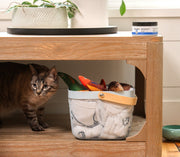How Much Litter Should Go in a Litter Box?
One of the many great things about cats is that you don’t have to worry about letting them outside to do their business. When they have litter boxes, cats will go to the bathroom on their own. Setting up a litter box properly can help make keeping the area clean easier and ensure that your cat will use the box when nature calls.
One of the most important aspects of getting the litter box ready is knowing how much cat litter to use. So, how much litter should be in a litter box? We provide tips on solving common litter box problems below.
Factors to Consider When Determining Amount of Litter
The truth is that there isn’t a simple rule for how much litter to put in a litter box. What works for one cat may not be ideal for another. Some factors that impact how much litter is necessary include:
- Size of the litter box: A bigger box will require more litter than a smaller one to fully cover the entire bottom.
- Type of litter box: Some types of litter boxes may require more litter. For example, self-cleaning robotic litter boxes often hold more than standard boxes. You may also need more litter if the box has a built-in filter screen.
- Number of cats: Generally, the more cats that you use the litter box, the more litter is necessary. Having more litter will help provide enough material for cats to dig and bury.
- Type of litter: If you’re using a clumping litter, you’ll likely need more because the level of loose litter will decrease as clumps form.
- Your cat’s habits: Some cats simply prefer more litter than others because of their individual habits.
Benefits of Using the Right Amount of Litter
Taking the time to figure out how much litter to put in a litter box is worth it. Some benefits of using the right amount of litter include:
- Simpler cleaning: When you have the right amount of litter in the box, cleaning up is easier. The optimal amount of litter will allow you to remove waste without excess digging and reduce the risk of urine and feces getting stuck to the bottom of the box.
- Improved odor control: Kitty litter naturally reduces odors to a certain extent. Using the right amount of litter can help to keep the area smelling fresher.
- Reduced waste: If litter levels are within the ideal range, your cat is less likely to knock excess litter out of the box. Not only does this mean that cleanup is easier, but it also reduces waste. Knowing how much litter to use also allows you to avoid overfilling, which can save you money over time.
- Happier, healthier pets: Cats are picky creatures. If the litter box isn’t up to their standards, they may choose to go to the bathroom somewhere else or become stressed. Some cats will even hold in urine and poop if they don’t like what’s available. Using the right amount of litter is one way to promote happier, healthier pets.
How to Determine the Right Amount of Litter
To determine the right amount of litter for a litter box, do the following:
- If you have one cat, add two to three inches of litter to the box. Use a ruler to measure the depth.
- Add an extra half inch for each additional cat.
- Observe your cat’s behaviors and assess the ease of cleanup for a few days.
- Try adding an additional half-inch of litter if you experience any problems.
- Once you have determined the right amount to use, draw a fill line on the litter box at the ideal height to simplify refills.
If you’re using a robotic litter box, check the manufacturer’s instructions. They should tell you how much litter is necessary for the box to work properly.
Common Litter Box Issues and How to Solve Them
Even if you carefully plan how much litter to use, you may still encounter challenges. Here are some of the most common litter box problems and what you can do about them:
- Lingering odors: If smells make being around the litter box unpleasant, place odor-removing products nearby. Fresh Wave Odor Removing Lemongrass Litter Box Gel is specially formulated to neutralize odors around the litter box and fills the air with a pleasant lemongrass scent. One jar can last 15 to 30 days, and the nontoxic plant-based ingredients are safe for cats and other pets.
- Litter box aversion: If your cat refuses to go, try increasing the amount of litter. You may also need to experiment with a different type of litter or a different style of box.
- Messes on the floor: If your cat frequently ends up going to the bathroom on the floor, they may be hanging over the edge of the box. Cats will do this if they don’t feel stable enough inside litter boxes. Using a sturdier box or adding more litter can help give your kitty a more secure feeling.
- Flinging litter: If your cat flings litter when they dig, the box might be too full. Reduce the amount of litter and see if the problem resolves.
- Slipping and sliding: If you notice or kitty slipping and sliding in the box, excess litter may be to blame. Using less litter could help your cat keep a surer footing.
Keep Your Kitty Happy and Your Home Smelling Fresh
Now that you know how to figure out how much litter in a litter box is right for your pet, you can get the area set up with ease. Putting the right amount of litter in the box will help ensure your feline fur baby is happy, healthy, and ready to go to the bathroom as needed. As you get the box ready, take steps to optimize maintenance. Organize supplies like spare litter, disposal bags, and scoops close by and add Fresh Wave products to the area to cut down on odors. Our products are free of harsh ingredients, making them safe to use around people and pets. Explore the Fresh wave product selection now to find the right odor-eliminating solutions for your litter box area.



